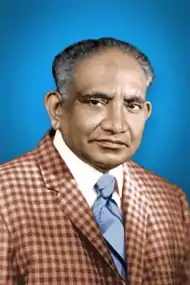Paulaseer Lawrie Muthukrishna (Lahari Krishna) | |
|---|---|
 | |
| Born | 24 February 1921 |
| Died | 24 February 1989 (aged 68) |
| Resting place | Manujothi Ashram, Tirunelveli, Tamil Nadu, India |
| Nationality | Indian |
| Other names | Gurudev Shri Lahari Krishna, Ayyah (Refers father in Tamil language) |
| Occupation | Religious leader |
| Employer(s) | The Galaha Co (Ceylon), Harrisons & Crossfield (Ceylon), Vellore Medical College Hospital (Vellore) |
| Known for | Faith healing |
| Spouse | Ebenezer Natchathram Lawrie |
| Children | • Deva Evu Manujothi Sathyaseelan • Devaaseer Emmanuel Lankadieu • Deva Dayavu Sanjeevi Chittaranjan |
| Parent(s) | Deva Rasiah (father) and Nesammal (mother) |
| Website | , , , , |
| Notes | |
Kalki Jeyanthi (Day of Vishwaroopa): 21 July 1969 | |
Paulaseer Lawrie Muthukrishna (24 February 1921 – 24 February 1989); was an Indian preacher who had followers worldwide. He is known for his faith-healing movement and initiated the "One God, One Nation movement" in India. He was a follower and promoter of the teachings of William Branham.[1]
Early life, education and early career
R. Paulaseer Lawrie was born to father, Deva Rasiah, and mother, Nesammal, at the Lakshmi Tea Estate in Munnar, Kerala.
Soon after his birth, the family moved to Ceylon (now Sri Lanka). Paulaseer stayed back to study at St. John's College, located in Palayamkottai, Tamil Nadu. After finishing the intermediate class of university studies, he went to Ceylon and studied commercial subjects for one year. He then went to Wesley College, Colombo, located in Colombo to gain the London Matric certificate.
After this, he went back to Madras, Tamil Nadu, and joined the Christian College, located in Tambaram, Tamil Nadu, for a Bachelor of Arts degree. As World War II began, a vigorous recruiting for officers was afoot. Paulaseer wanted to join the Indian Army and took some training. On knowing this, his father came over and forced Paulaseer to return with him to Ceylon. Paulaseer came back to India to continue his studies. He got a seat in St. Xavier's College, located in Palayamkottai, Tamil Nadu.
In August 1942, when the national leaders launched the Quit India Movement, he organized a big student strike in his college. The police attempted to apprehend him, but he managed to escape to Ceylon where, soon after arrival, he got a job in one of the tea estates as a stenographer.[2] Around this time Paulaseer began to read political and religious works and to have visions. In 1946, he went to India on a short holiday. While going with his mother to a friend's house, he saw everything according to the dreams he had had about his wife-to-be. Thus assured that the girl in that house was the one chosen by the Lord, he consented to marry, and they were engaged. His mother was there, but his father was in Ceylon. So the marriage had to be postponed for six months; it occurred 26 May 1947.
When his first child was seriously ill, Paulaseer prayed and promised to devote his life to God if the child recovered. After his son's recovery, he resigned his job in Ceylon and returned to India. He took a job on the Yercaud Estate, located in Tamil Nadu, and later at the Christian Medical College Hospital, (CMCH)[3] located in Vellore, Tamil Nadu.
See also
- List of 20th-century religious leaders
- List of people from Kerala
- List of people from Tamil Nadu
- List of Protestant missionaries in India
References
- ↑ Photos of DAYS OF KALKI MAHA AVATAR
- ↑ Bergunder, Michael (2003). "From Pentecostal Healing Evangelist to Kalki Avatar", in Christians and Missionaries in India: Cross-Cultural Communication since 1500, edited by Robert Eric Frykenberg and Alaine M. Low. Wm. B. Eerdmans Publishing. p. 359.
- ↑